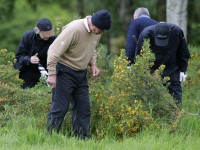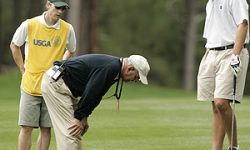Each week, I will cover a rule that frequently comes into question during amateur golf tournaments. This weekly Club Golf Academy segment will be covering rules that I believe all NCCGA players should know and understand.
Why play a provisional ball?
This week’s USGA Rule of the Week is Rule 27; concerning provisional balls. A provisional ball is an additional ball played under Rule 27 for a ball that may be lost in a water hazard or out of bounds. Playing a provisional ball allows players to re-hit without having to walk back to the original spot of the ball if it is lost or out-of-bounds. Playing a provisional will not only save you from the “walk of shame”, but more importantly, will also greatly help with pace of play.
There are two scenarios where you would be assessed a penalty of stroke and distance:
1). You cannot find your original ball within the allotted 5 minute search period
2). Your ball is out-of-bounds
In both scenarios, you would be required to go back to the original spot of your ball and play another ball in addition to incurring a penalty stroke. The only times you are allowed to play a provisional ball are when you face one of the two scenarios previously described.
In order for your second ball to be considered a provisional shot, you must announce to your competitors that you intend to play a provisional. Do not forget to identify the make and number of the provisional ball. Additionally, you must hit your provisional ball before you or anyone else in your group goes up to look for your original ball. If you hit a ball after you have gone up to look for your original ball, your original ball is considered lost or out-of-bounds and your second ball becomes "in-play".
When does the provisional ball become the ball in play?
A player may play a provisional ball until he/she reaches the place where the original ball is likely to be. If he/she makes a stroke with the provisional ball from the place where the original ball is likely to be or from a point nearer the hole than that place, the original ball is lost and the provisional ball becomes the ball in play under penalty of stroke and distance; Rule 27-1. Also, once the five minute search period for your original ball is over, your provisional ball becomes the ball in play. Furthermore, if the original ball is lost in a water hazard or is out of bounds, the provisional ball becomes the ball in play, under penalty of stroke and distance; Rule 27-1.
Situations where you cannot play a provisional ball.
If you hit your ball toward a hazard and think that you will not find it solely because it is in the hazard, you may not play a provisional. If you play a second ball, that ball becomes your ball in play and counts as one of your relief options from said hazard. Exception: If you hit your ball and are uncertain whether it went into the hazard or an adjoining strip of land (that is not part of the hazard), you are permitted to hit a provisional ball. If you find your ball in the adjoining strip of land, you may play it as usual and disregard the provisional ball.
If you find your original ball in the hazard or deem that it went in the hazard, you can either play the ball as it lies out of the hazard or take one of the normal relief options from a hazard. If you are uncertain as to whether your original ball ended up in the hazard or not, you should treat it as a lost ball and your provisional ball becomes your ball in play.
For more information about provisionals, watch this informative video courtesy of the USGA Rules.
**Written by Nicholas Heyrman, Director of Tournament Operations. If you have any recommendations or suggestions on how to improve the NCCGA tournament experience or rules questions email Nick at ops@nccga.org, or on Twitter @NCCGATourneys.




